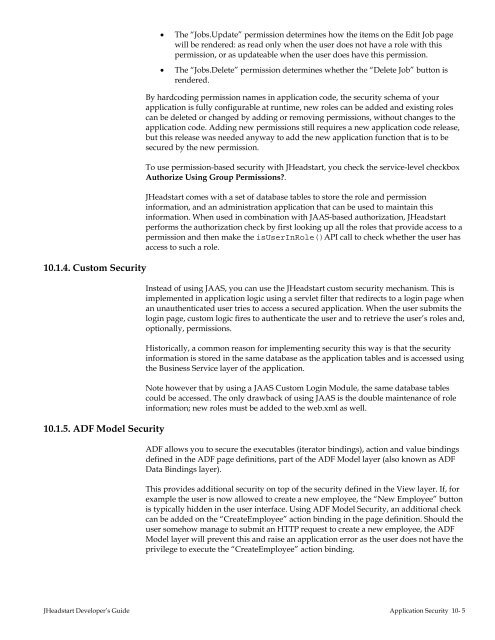Oracle JHeadstart Developer's Guide - Downloads - Oracle
Oracle JHeadstart Developer's Guide - Downloads - Oracle
Oracle JHeadstart Developer's Guide - Downloads - Oracle
You also want an ePaper? Increase the reach of your titles
YUMPU automatically turns print PDFs into web optimized ePapers that Google loves.
10.1.4. Custom Security<br />
10.1.5. ADF Model Security<br />
• The “Jobs.Update” permission determines how the items on the Edit Job page<br />
will be rendered: as read only when the user does not have a role with this<br />
permission, or as updateable when the user does have this permission.<br />
• The “Jobs.Delete” permission determines whether the “Delete Job” button is<br />
rendered.<br />
By hardcoding permission names in application code, the security schema of your<br />
application is fully configurable at runtime, new roles can be added and existing roles<br />
can be deleted or changed by adding or removing permissions, without changes to the<br />
application code. Adding new permissions still requires a new application code release,<br />
but this release was needed anyway to add the new application function that is to be<br />
secured by the new permission.<br />
To use permission-based security with <strong>JHeadstart</strong>, you check the service-level checkbox<br />
Authorize Using Group Permissions?.<br />
<strong>JHeadstart</strong> comes with a set of database tables to store the role and permission<br />
information, and an administration application that can be used to maintain this<br />
information. When used in combination with JAAS-based authorization, <strong>JHeadstart</strong><br />
performs the authorization check by first looking up all the roles that provide access to a<br />
permission and then make the isUserInRole()API call to check whether the user has<br />
access to such a role.<br />
Instead of using JAAS, you can use the <strong>JHeadstart</strong> custom security mechanism. This is<br />
implemented in application logic using a servlet filter that redirects to a login page when<br />
an unauthenticated user tries to access a secured application. When the user submits the<br />
login page, custom logic fires to authenticate the user and to retrieve the user’s roles and,<br />
optionally, permissions.<br />
Historically, a common reason for implementing security this way is that the security<br />
information is stored in the same database as the application tables and is accessed using<br />
the Business Service layer of the application.<br />
Note however that by using a JAAS Custom Login Module, the same database tables<br />
could be accessed. The only drawback of using JAAS is the double maintenance of role<br />
information; new roles must be added to the web.xml as well.<br />
ADF allows you to secure the executables (iterator bindings), action and value bindings<br />
defined in the ADF page definitions, part of the ADF Model layer (also known as ADF<br />
Data Bindings layer).<br />
This provides additional security on top of the security defined in the View layer. If, for<br />
example the user is now allowed to create a new employee, the “New Employee” button<br />
is typically hidden in the user interface. Using ADF Model Security, an additional check<br />
can be added on the “CreateEmployee” action binding in the page definition. Should the<br />
user somehow manage to submit an HTTP request to create a new employee, the ADF<br />
Model layer will prevent this and raise an application error as the user does not have the<br />
privilege to execute the “CreateEmployee” action binding.<br />
<strong>JHeadstart</strong> Developer’s <strong>Guide</strong> Application Security 10- 5
















